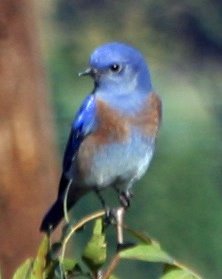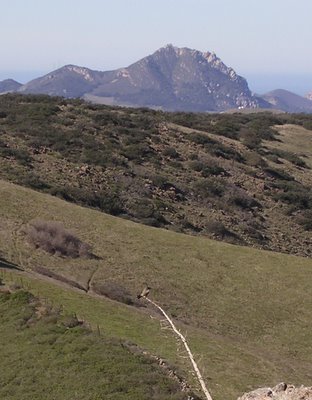Territoriality
Today’s ecolit class was a hike to Rockslide Ridge.

We’ve been reading John Muir’s The Mountains of California. Its first paragraph contains a fine description of our home territory.
The Coast Range, rising as a grand green barrier against the ocean, from 2000 to 8000 feet high, is composed of innumerable forest-crowned spurs, ridges, and rolling hill-waves which inclose a multitude of smaller valleys; some looking out through long, forest-lined vistas to the sea; others, with but few trees, to the Central Valley; while a thousand others yet smaller are embosomed and concealed in mild, round-browed hills, each with its own climate, soil, and productions.
I’d asked students to study the Geology chapter of Cal Poly Land: A Field Guide to connect the Muir text to our walk and to help them to decipher some of the language of the landscape.
The winter weather was clear and crisp. On my way up to our meeting place at the horse unit, I biked toward Drumm Reservoir and the site of “Poly Canyon Village,” a huge new student residential development I’d spent many hours haggling about in committee during the last five years. I’d just learned from reading Christy’s ecolit journal that groundbreaking started two days before with the destruction of ancient Eucalyptus trees:
Driving up to Peterson ranch this afternoon I was shocked to come across the mass arboreal murder taking place. The beautiful eucalyptus trees that have shaded the feed mill, the feedlot, and the bull test are being savagely mown down by hairy, overweight cretins in fluorescent vests. In the summer when it gets unbearably hot, there is some much needed comforting shade under these fragrant guardians. During wind-whipped storms, their branches sway and shed leaves in all directions. They hold the land stable; they act as nice bumpers for those whose breaking skills are not up to par. To me they stand watching over year after year of Cal Poly students. They have seen the succession of eager high school potential, to Poly student to teacher, teacher to department head, then to retirement. …Just five days ago, I walked to my car parked under those fated Eucalypts, listening to the eerie creaking and groaning of the trees, despite the dead stillness in the air. They knew, and they were broadcasting their goodbyes through the song of their branches.
I found only huge stumps, cut close to the ground. The rings werent visible enough to be counted.
While we waited for stragglers, I pointed out the borders of Cal Poly Land on the map. Our destination was just outside the property line. At exactly 10:15 by my watch, we started up the hill. Every minute counted if we were to be back in time for the next scheduled class at noon.
The horse corral above the stables provided a lesson in erosion and land misuse. As a flock of crows cawed in the twisted sycamore limbs, one student pointed out a foot-high gap between the ground and the concrete foundation of a watering trough, measuring the loss of topsoil.
At the top of the corral we came upon Indonesian reservoir, designed and built by a group of Indonesian students in the ’60’s to impound runoff from Horse canyon creek in front of us and water pumped uphill from the system of reservoirs, ditches, pipes and creeks that serve as plumbing to irrigate campus farm facilities. I pointed out Kestrel Crest, the serpentinite ridge above the reservoir. Kestrel was defined as a small raptor, a sparrow hawk. Kiell mentioned that it was also a verb that meant hovering in flight. As if on cue, two small birds with white spots on their wings–not kestrels–appeared below the crest and kestrelled for us. Another bird flashed grey-blue and light orange. I recognized it and three more that joined it, as female Western Bluebirds, Sialia mexicana. Not as impressive as the more brightly colored male I had photographed last year from my deck

 they nevertheless gave me a thrill when their gray wings suddenly turned blue as they angled in the sun.
they nevertheless gave me a thrill when their gray wings suddenly turned blue as they angled in the sun.
After a brief stop at bedrock mortars surrounding a grove of bay and hollyleaf cherries under the high voltage lines bringing power to the campus from the grid in Morro Bay, we huffed uphill on a deeply eroded dirt road past some recent slumpage in the Franciscan melange soils on the bank, passing through a shaded oak woodland along the creek. The woodland gave way to grassland and then to rock outcrop plant communities growing on the base of the steep upper slopes that constituted Rockslide Ridge. Despite an increase of wind, the temperature went up, and I had to remove my sweater and take a drink.
At the saddle dividing Horse Canyon from Poly Canyon, some people decided to ascend no further, while the rest of us left the road and found various paths through the unstable rock and gravel, avoiding the needle pointed tips of Spanish Dagger that thrived without much competition on the infertile serpentinite soil. Most of the group had never seen this backcountry before. Other people delighted in the escape during class hours. I watched the clock, knowing we had to reach the top by 11 in order to have fifteen minutes there before going back down.
I was one of the last near the summit to clamber over a barbed wire fence that ended in a vertical drop-off where half the mountain had shaken loose and slid down into the valley that was now the Architectural Area. Instructed by Professor Chipping’s explanations in the Field Guide, one could see where springs erupting from impermeable layers of rock covered by the slides secreted watercourses lined with green black clumps of trees–oaks, bays, sycamores and willows.
I collected papers due today and then people dispersed on the summit plateau, just outside the University property line to write in their journals.
I found a natural rock bench, drank some water, munched on a chunk of olive bread and looked for a subject to describe. Just to my west, on a dried flower stalk of Yucca whipplei, perched another female bluebird. I approached her slowly to get a picture, and she let me come within 20 feet.

Then she disappeared and I went back to my seat. Looking to the south, over the campus toward the city in the distance, I saw her on another stalk, watching me.
 I approached again. This time she flew directly toward me and fluttered in an arabesque a few feet from my eyes. At first I told myself she was rewarding my attentions. But then I realized this was threat behavior. I was doubly trespassing, my sit-spot in the middle of her territory, between her guard towers. I checked my watch. It was three minutes after the time to leave.
I approached again. This time she flew directly toward me and fluttered in an arabesque a few feet from my eyes. At first I told myself she was rewarding my attentions. But then I realized this was threat behavior. I was doubly trespassing, my sit-spot in the middle of her territory, between her guard towers. I checked my watch. It was three minutes after the time to leave.

